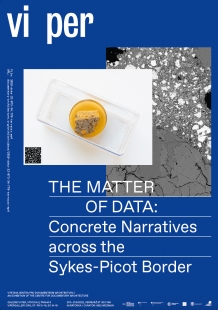
The Matter of Data - exhibition at Gallery VI PER
Concrete Narratives across the Sykes-Picot Border
Source
Galerie VI PER
Galerie VI PER
Publisher
Tisková zpráva
24.03.2022 10:10
Tisková zpráva
24.03.2022 10:10
Exhibitions
Czech Republic
Prague
Karlín
Interest in the multifaceted meanings and complex histories of architectural modernisms, including their histories filled with migrations and displacements, as well as the effort to connect a dispersed body of acquired knowledge, has led the Centre for Documentary Architecture (CDA) to begin applying the method of "documentary architecture" (which has also given this institution its name). What does it actually mean? It is the combination of physical cues with digital traces in a way that allows the exploration of geography across scales – from the grain of aggregate in concrete to the geopolitical formation of entire regions – and across history, from the beginning of the Weimar era to the present.
The exhibition When Data Speaks: Stories of Concrete at the Sykes-Picot Boundary addresses architecture on both sides of the infamous Sykes-Picot line. This boundary, established by a secret treaty between Great Britain and France in 1916, divided the former Ottoman Empire and has since been an ever-explosive trigger of unending conflict. Based on case studies aimed at mapping the politics and logistics of transporting building materials, with a particular emphasis on (white) cement, architecture is presented as a documentation of historical and political contexts.
The research into the materiality of modernist architecture aims to connect specific buildings not only with the complex histories of colonial dominance and occupation in the region but also with networks of architects, building patrons, traders, and builders of modern architecture across Palestine and the Arab world, as well as with trans-Arab infrastructures and trade or exchange routes that have now disappeared.
In order to connect this dispersed body of knowledge, it is necessary to apply a cross-border and, at the same time, open approach to data. The conceptual foundation of the exhibition is organized along two axes, of matter and data, which connect film documentation, archival studies, material analysis, and digital documentation of buildings into a presentation that is both tactile and media-oriented. Architectural case studies – presented as “architectural biographies” – become the key to understanding bureaucratic measures, abstract economic principles, and political relations, while materials are examined within the spectrum of microhistory and macro-cartography.
The fascination of modernism with colorful coatings arose from its popularity for smooth surfaces, but when these layers are stripped away, the archaeology of modernism is forced to reveal its layers of fossilized past. The depth of a wall is the "unconscious" of the building. With this new sensitivity of documentary architecture and through the critical use of new technologies, we can begin to make sense of the scattered molecular fragments of history – the clouds of dust raised by the military leaders of this region, dispersed across borders drawn in sand, which were then marked in concrete. These are then gathered in the depths of buildings – and subsequently collected into data.
The exhibition presents research and documentation from the ever-expanding digital archive of the Centre for Documentary Architecture, an interdisciplinary research collective of architectural historians, filmmakers, and digital technologists. It is part of ongoing research focused on architectural modernisms and their histories of migrations and displacements, as well as their various subsequent lives and reinterpretations.
Curator: Ines Weizman
The exhibition When Data Speaks: Stories of Concrete at the Sykes-Picot Boundary addresses architecture on both sides of the infamous Sykes-Picot line. This boundary, established by a secret treaty between Great Britain and France in 1916, divided the former Ottoman Empire and has since been an ever-explosive trigger of unending conflict. Based on case studies aimed at mapping the politics and logistics of transporting building materials, with a particular emphasis on (white) cement, architecture is presented as a documentation of historical and political contexts.
The research into the materiality of modernist architecture aims to connect specific buildings not only with the complex histories of colonial dominance and occupation in the region but also with networks of architects, building patrons, traders, and builders of modern architecture across Palestine and the Arab world, as well as with trans-Arab infrastructures and trade or exchange routes that have now disappeared.
In order to connect this dispersed body of knowledge, it is necessary to apply a cross-border and, at the same time, open approach to data. The conceptual foundation of the exhibition is organized along two axes, of matter and data, which connect film documentation, archival studies, material analysis, and digital documentation of buildings into a presentation that is both tactile and media-oriented. Architectural case studies – presented as “architectural biographies” – become the key to understanding bureaucratic measures, abstract economic principles, and political relations, while materials are examined within the spectrum of microhistory and macro-cartography.
The fascination of modernism with colorful coatings arose from its popularity for smooth surfaces, but when these layers are stripped away, the archaeology of modernism is forced to reveal its layers of fossilized past. The depth of a wall is the "unconscious" of the building. With this new sensitivity of documentary architecture and through the critical use of new technologies, we can begin to make sense of the scattered molecular fragments of history – the clouds of dust raised by the military leaders of this region, dispersed across borders drawn in sand, which were then marked in concrete. These are then gathered in the depths of buildings – and subsequently collected into data.
The exhibition presents research and documentation from the ever-expanding digital archive of the Centre for Documentary Architecture, an interdisciplinary research collective of architectural historians, filmmakers, and digital technologists. It is part of ongoing research focused on architectural modernisms and their histories of migrations and displacements, as well as their various subsequent lives and reinterpretations.
Curator: Ines Weizman
The English translation is powered by AI tool. Switch to Czech to view the original text source.

0 comments
add comment











